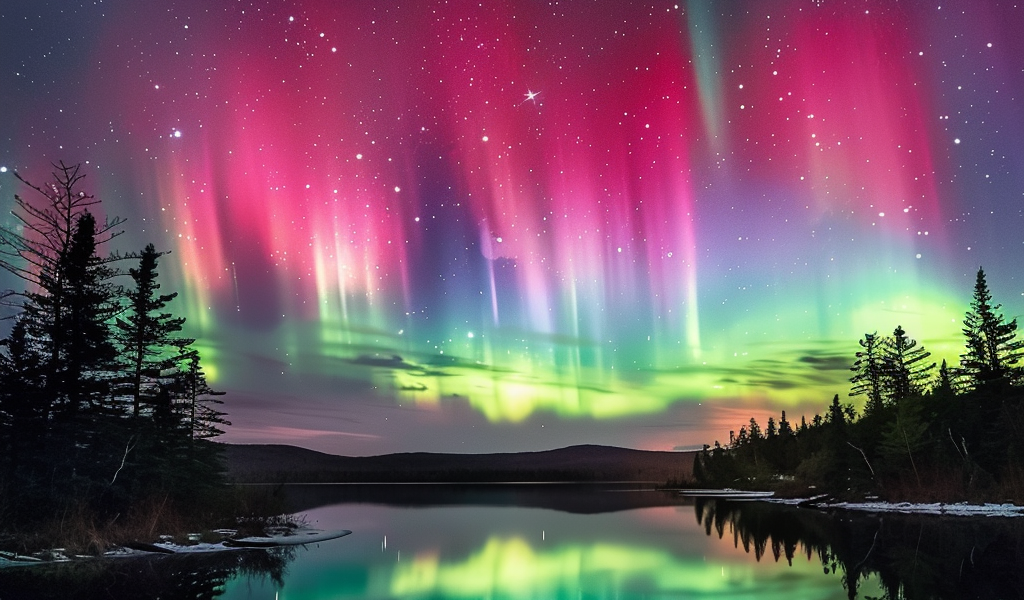As the summer season unfolds, residents of Central Maine are gearing up for a spectacular astronomical event: the potential visibility of the northern lights, also known as the aurora borealis. This week, a medium-sized solar storm is expected to sweep across the region, providing an exciting opportunity for stargazers and nature enthusiasts alike to witness this natural phenomenon.
The National Oceanic and Atmospheric Administration (NOAA) has issued forecasts indicating that the solar storm will begin around 8 p.m. on Tuesday, with its peak intensity anticipated at approximately 2 a.m. on Wednesday. This timing presents an excellent chance for those in central and northern Maine, particularly in areas such as Skowhegan and points further north, to catch a glimpse of the dazzling lights.
This year has been particularly favorable for aurora viewing, with experts predicting that the northern lights will continue to illuminate Maine’s skies well into the fall months. Local astronomers and enthusiasts are eagerly awaiting this upcoming display, which is part of a broader trend of increased solar activity.
Elizabeth Dickerson, a seasoned citizen astronomer from Union, has dedicated nearly three decades to monitoring the aurora over Maine. She emphasizes that the visibility of the northern lights during this solar storm will largely depend on two key factors: the weather conditions and the phase of the moon. “The trick is to time things when the moon isn’t up yet or has set,” Dickerson explains. “This time of year, with limited darkness, it requires a lot of cooperation from the aurora. It may hit when it is still light and when the moon is still super big.”
NOAA’s forecasts indicate that the southern edge of the aurora will likely traverse Maine, with Somerset, Aroostook, and Piscataquis counties being prime locations for optimal viewing. The intensity of solar storms is measured using the Kp index, which ranges from zero (indicating dimmer storms) to nine (indicating powerful storms that can be seen in the contiguous U.S.). This week’s solar storm is predicted to reach a Kp value of approximately 5.67 at its peak, comparable to the significant solar storm that occurred in April.
In May, a particularly intense solar storm produced vibrant pink auroras across much of Maine, achieving a Kp level of 9. While storms with a Kp index below 7 can be challenging for the naked eye to perceive, many smartphones are equipped to capture the beauty of the aurora through long-exposure photography, making it possible for people to document the event even if visibility is limited.
As the solar storm approaches, experts caution that the success of aurora sightings will be contingent on the brightness of the moon and the presence of clouds in the sky. The moon is expected to rise just after 9:30 p.m. on Tuesday, approximately an hour and a half after the solar storm begins. This timing could impact the visibility of the northern lights, as a bright moon may overshadow the subtle hues of the aurora.
For those hoping to witness this celestial display, it is advisable to find locations with minimal light pollution and a clear view of the northern horizon. As the solar storm approaches its peak, enthusiasts should prepare to venture outside, equipped with warm clothing and cameras ready to capture the moment.
As the solar cycle continues to ramp up, the potential for more aurora events in the coming months remains high. Maine residents are encouraged to stay informed about solar activity and to seize opportunities to experience the beauty of the northern lights firsthand. With the right conditions, the skies over Maine may soon be ablaze with the stunning colors of the aurora borealis, creating unforgettable memories for all who are fortunate enough to witness it.





